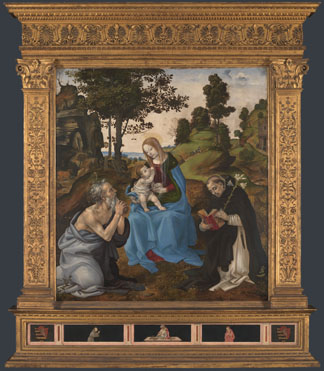Upon entering Saint-Martin-in-the-Fields, early this afternoon for the E.L.F. trio, I thought I had a pretty good idea of what to expect from the concert and the church. I’ve been in a good number of European churches, and I admit that I’ve gotten a bit jaded on the church front. I wasn’t surprised by the decor of the church (Corinthian columns, gilded decoration, chandeliers, etc). It was quite typical of a church built in the mid-1700s. I was, however, quite enthralled by the window over the main altar of the church. Unfortunately, I couldn’t take a picture of it from the church, but it seemed to be purposely distorted into a display of modern art and it certainly made an interesting juxtaposition with the existing 18th century decor and architecture. (I was unable to find more information to tell if it is an original piece of the church or a more recent addition.)
The E.L.F. trio also managed to surprise me greatly! As much as I enjoyed it, I was notexpecting a 35 minute long tribute to Andrew Lloyd Webber’s Phantom of the Opera! Anyone else have an overwhelming desire to listen to the Phantom soundtrack after that?
The National Gallery was probably the highlight of my day. Anyone who knows me really well can tell you that I love music and theatre, but I’m not one much for old paintings. We were told that when we go to the British Museum we should keep in mind how the different artefacts relate to Great Britain. Along those same lines in the National Gallery I couldn’t help but keep thinking about how the paintings managed to get to London. The ones that were by British artists or of Britain or by an artist from the Empire made sense, but how did they get such a large number of paintings from Germany, the Netherlands, Italy, etc.? What really shocked me were the 13th to 15th century paintings that used to be altarpieces in churches. There was one by Filippino Lippi, called The Virgin and Child with Saints Jerome and Dominic, from about1485 that was painted for San Pencrazio church in Florence. How did these pieces of art from the walls of churches manage to get to London? I just had a bit of an issue getting my head around the idea that so many of these fragile pieces of artwork were cut up and shipped to London museums from places that were outside of Britain’s sphere of influence.

The Virgin and Child with Saints Jerome and Dominic by Filippino Lippi - picture taken from the website of the National Gallery
As I said above, I am not one who is a big fan of looking at old paintings for hours on end, but I know the big names and can recognize my fair share of famous paintings. One of the things I appreciated and was in awe of most about the National Gallery was the sheer volume of paintings they had that I was familiar with. There was one room with twenty-one paintings on the walls and I counted nine by Raphael and two by Michelangelo. (I came to realize that you could tell where a really famous painting or artist’s work was when there was a massive group of people surrounding it and traffic stopped flowing.) The US has some really nice art museums, but the content of the National Gallery blew my mind.
The main thing I learned today is that art and music transcend all language barriers. I probably heard people speaking at least a dozen different languages when I was strolling around the National Gallery and sitting in Saint-Martin-in-the-Fields, but it didn’t matter because everyone can enjoy art and it is completely open to interpretation.

2 responses so far ↓
Brandon R. // Aug 25th 2009 at 18:04
Kelley – you touched on many of the things I noticed today between watching the E.L.F. Trio (fantastic concert–couldn’t have asked for a better time) and wandering through about what seemed to be .00001% of the National Gallery. First, how did Britain get these paintings from around the world? I tried to compare the diversity of art to the Museum of Art in Philadelphia, which houses several non-American artists. Many are purchased, many are on loan, and, as we’ve learned, some are even arguably stolen. (Maybe this could be a potential research topic – the “stolen” art of the British empire?)
I was reading an article recently (search “At Louvre, Many Stop to Snap but Few Stay to Focus” on nytimes.com and read that article – – for some reason it will not post!) that addresses your sentiment towards looking at art as intensely as others. I, admittedly, look for the big names or at least those works I recognize.
I found the National Gallery just staggering. The Philadelphia Museum pales in comparison. However, what struck me most was the National Portrait Gallery. I did not expect much from this museum, but it’s range as well as its attention to such a wide array of people present in British history and culture was jaw-dropping. What an incredible museum. I couldn’t have been more impressed, stunned, and refreshed after walking through that museum. It was just awesome. If you or anyone else has not had the opportunity to visit the museum, please do (also visit the National Gallery — it’s just as stunning).
kstaab77 // Aug 25th 2009 at 18:24
Brandon, thanks for mentioning that article. I found it to be scarily accurate; both in what I have observed and what I often practice in art museums.
You must log in to post a comment.